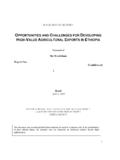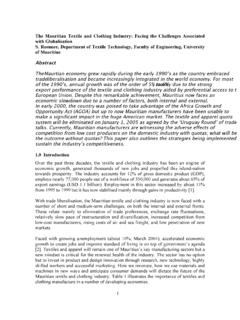Transcription of Growth and Transformation Plan (GTP) 2010/11 …
1 The Federal Democratic Republic of Ethiopia Growth and Transformation Plan (GTP). 2010/11 -2014/15. Draft Ministry of Finance and Economic Development (MoFED). September 2010. Addis Ababa 1. Table of Contents Title Page Introduction 1. Chapter 1 Progress and challenges under PASDEP 3. Chapter 2 The Bases and Objectives of GTP 5. Chapter 3 Pillar Strategies of GTP 6. Chapter 4 Macroeconomic Framework and Growth 11. Chapter 5 Economic Sector Development Plan 17. Chapter 6 Social Sector Development Plan 47. Chapter 7 Capacity Building and Good Governance 55. Chapter 8 Cross-Cutting Sectors Development Plan 69.
2 Chapter 9 Opportunities and challenges , and 77. Chapter 10 Monitoring and Evaluation of GTP 81. 2. Introduction This document describes Ethiopia's Growth and Transformation Plan (GTP), a medium term strategic framework for the five-year period ( 2010/11 -2014/15). As the GTP is in the preparation process, it has been passing through an extensive process of consultation with citizens, the private sector, and civil society including women and youth organizations, religious institutions, the academia including professional associations both at regional and federal levels.
3 This English version of the GTP is prepared to facilitate discussion with our development partners. Chapter 1. Progress and challenges under PASDEP. The development policies and strategies pursued during Sustainable Development and Poverty Reduction Program (SDPRP), the country's vision and achievements registered under SDPRP were the basis for the PASDEP. The Plan for Accelerated and Sustained Development to End Poverty (PASDEP) is the First Five Year Phase to attain the goals and targets set in the MDGs at a minimum. The main objective of the PASDEP is to lay out the directions for accelerated, sustained, and people-centered economic development as well as to pave the groundwork for the attainment of the MDGs by 2015.
4 Eight Pillar Strategies were developed under PASDEP which have been carrying forward important strategic directions pursued under SDPRP and also embodying some bold new directions. Foremost among them is a major focus on Growth with a particular emphasis on greater commercialization of agriculture and enhancing private sector development, industry, urban development and a scaling- up of efforts to achieve the Millennium Development Goals (MDGs). These pillar strategies were: Building all-inclusive implementation capacity;. A massive push to accelerate Growth .
5 Creating the balance between economic development and population Growth ;. Unleashing the potentials of Ethiopia's women;. Strengthening the infrastructure backbone of the country;. Strengthening human resource development;. Managing risk and volatility; and, Creating employment opportunities. To realize the objective of PASDEP by employing the above pillar strategies, the Government had established two alternative Growth scenarios under PASDEP. The first scenario (the base case) was established in line with the requirements of MDGs, while the second scenario (the high case) which is equivalent to the 'MDGs Plus' scenario was based on the requirements of the country's vision.
6 In the base case scenario, 7 % annual average real GDP Growth was targeted while the target in the higher case scenario was set at an average real GDP Growth of 10 %. In both scenarios the performance achieved in the past five years of PASDEP implementation was remarkable (Table 1). Table Growth Targets and Performance under PASDEP. Sector Average Growth Targets Average Growth (2005/06-2009/10) Achieved Base case High case scenario (2005/06-2009/10). scenario Real GDP (%) Agriculture and allied activities Industry Services 4. As shown in Table 1 above, the Growth performance as measured by real GDP Growth has exceeded the Growth targets set under both scenarios of PASDEP.
7 The registered GDP Growth rate, in comparison with an average population Growth rate of , implies that the average annual per capita income Growth rate was %. The shift to a high Growth path due to a combination of emphasis on diversification and commercialization of small scale agriculture , expansion of non-agricultural production in services and industry, capacity building and good governance, off farm employment especially through small enterprises, massive investment in infrastructure Major challenges Encountered The major challenges encountered in the past five years of PASDEP implementation were.
8 - High inflationary pressure which partly induced by external factors was a serious challenge to the macroeconomic stability. However, this inflationary challenge had been effectively managed by the Government to a single digit through fiscal and monetary policy and administrative measures. Inadequate capacity for domestic revenue collection was another challenge encountered during the period of PASDEP implementation. This challenge has significantly improved through reform and administrative measures of the government towards the end of the planning period.
9 Low level of domestic savings to support the huge demand of the country's investment for accelerating Growth and development in the process of eradicating poverty. In some areas of the country, delayed entrance of rainy seasons, early withdrawal and mal- distribution of rain were challenges from which great lessons have been drawn to seriously look into expansion of small, medium and large scale irrigation in perspective. Lessons Drawn The lessons drawn from the implementation of PASDEP include:- Best experiences have been drawn in the process of leading and managing the economy on how to coordinate and mobilize the people at large, the private sector and non government organization for accelerated and sustained Growth .
10 A number of model farmers who registered the highest productivity and production, particularly in agricultural sector have been emerged. Best practices of these model farmers for increased productivity and production have been drawn for scaling up to the rest of the farmers in the upcoming five year Growth and Transformation Plan so as to increase productivity and production of most of farmers nearer to the model farmers. 5. 6. Chapter 2. Bases and Objectives of the Plan Bases of Growth and Transformation Plan The country's long term vision, achievements of PASDEP and lessons drawn from its implementation are the bases for conceiving the next five year Growth and Transformation Plan.







